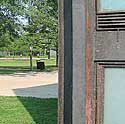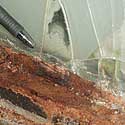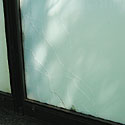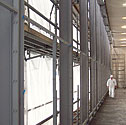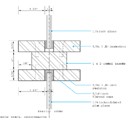The Perils of Restoring
Ronald Krueck, FAIA, and Sexton, both alumni of IIT, were well aware that the starkness of Mies's work does not equate to simplicity, nor was his bias in favor of off-the-shelf components suggest a generic architectural vocabulary. They were ready to preserve and protect every detail, adjacency, span, and material. Still, it takes a lot of research and study to restore "almost nothing." The architects were fortunate to have the services of preservation consultant Gunny Harboe, AIA, of Austin AECOM (formerly McClier).
The scope of work was extensive: The sandblast removal of all lead-based paint from interior and exterior steel and repairs to the members that had rusted. The steel hadn't been repainted in 25 years, so the dense "Miesian black" from photographs had faded to a dull gray. The glass panels did not conform to any code, so they had to be replaced, and the steel stops redesigned. The process also involved refurbishment and reactivation of the blinds, disassembling and retrofitting them with electromagnetic release hardware, and refurbishing the original Ellison stainless-steel doors on the north and south facades. Finally, the $3.6 million renovation included upgrading the bathrooms to meet current ADA accessibility standards.
Obviously, the restoration didn't actually take place in 15 weeks, as the closing ceremony pronouncements suggested. Assessment of the existing conditions, study of Mies's details, and the final design solution evolved over a two-year period. The actual demolition and construction lasted 15 weeks, but when the symbolic shattering took place, every beam, frame, and pane of glass was already fabricated and waiting for assembly nearby. The planning process was methodical, and the execution surgically precise. Much of the credit for this goes to Clune Construction Company, whose scheduling and coordination of the demolition, repair, and reconstruction sequences included a contingency plan for dealing with and solving unforeseen problems while staying on schedule.
|
|||||||||||||
The first task was to quickly shroud the entire building in order to contain dust from the lead-based paint that was to be sandblasted off all the steel members. "We divided the building into quadrants," explained Michael A. Tenuta, senior vice president of Clune Construction. "Sandblasting the steel was followed by an inspection, then more sandblasting, then repairs, then another inspection, then the first of three coats of paint. There was no float time, and there was a constantly roving punch list."





